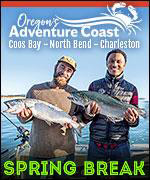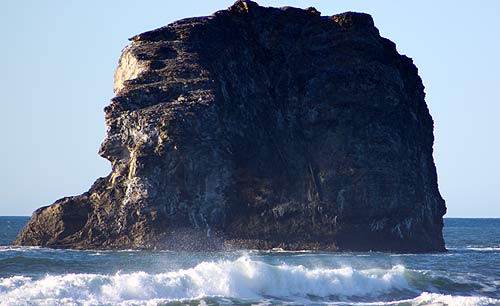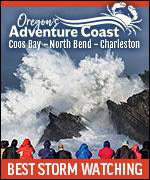Weird Science of Rockaway Beach's Twin Rocks, N. Oregon Coast: Video
Published 02/17/2020 at 12:28 AM PDT
By Oregon Coast Beach Connection staff
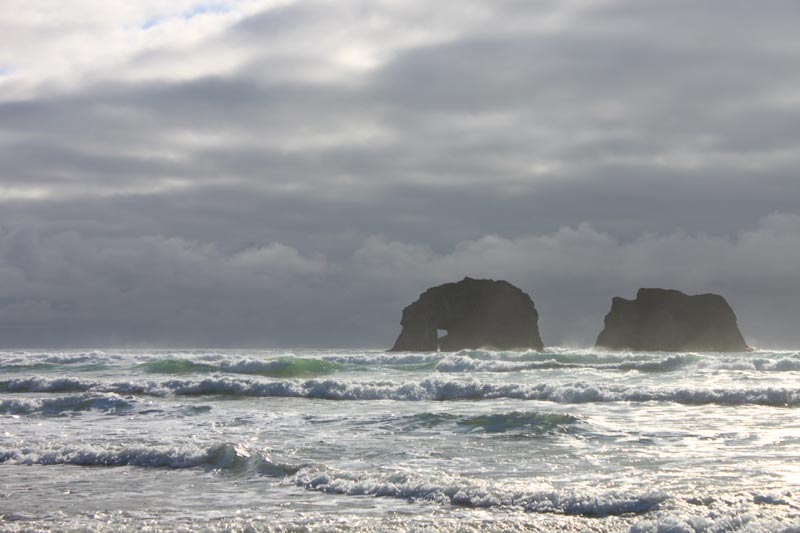
(Rockaway Beach, Oregon) – Twin Rocks at Rockaway Beach has been the big scenic highlight since day one that settlers appeared here, and long before that when indigenous people first arrived as well. What legends grew around that sight isn’t exactly clear, though there were likely numerous interpretations – just like today, when some say it looks like a dragon or other fanciful creature.
The truth, however, is stranger than fiction about this famed Oregon coast landmark. Twin Rocks has a weird little secret.
It’s probably – geologically speaking – not what you think it is. A lot of people at first guess think it was once part of a larger structure, and they’d have it half correct. Twin Rocks is what they call in geology an “intrusive.” Yes, it’s lava – originally. But it has the unusual distinction of being part of a much bigger lava flow that entered into the ground and re-erupted elsewhere.
Includes exclusive listings; some specials in winter
In Cannon Beach:
Includes rentals not listed anywhere else
In Manzanita, Wheeler, Rockaway Beach:
Some specials for winter
In Pacific City, Oceanside:
Some specials for winter
In Lincoln City:
Some specials for winter
In Depoe Bay, Gleneden Beach:
Some specials for winter
In Newport:
Look for some specials
In Waldport
Some specials for winter
In Yachats, Florence
Some specials for winter
The solid-as-rock definition (pun intended) of an intrusive is lava that reaches the surface from below. But this is usually used when talking about magma chambers and much more expansive volcono-like things. However, there are times a major lava flow goes scooting its way along the surface and then dives into softer sediment, burrows down, and then comes back up.
According to north Oregon coast geologist Tom Horning:
“Sometimes, lavas burrow into muck and re-erupt like Haystack has,” he said, referring to Cannon Beach’s Haystack Rock.
Twin Rocks, according to Horning and other Oregon science folk, has the same kind of origin story.
Somewhere about 18 to 15 million years ago, the coastline was some 75 to 100 miles farther inland than it is now, and all that you see here was under water. About that time, there was an enormous weak spot in the Earth’s crust roughly where the Idaho / Oregon border is now. (Spoiler alert: this weak spot, Oregon coast landmarks and Yellowstone National Park are all related). This let loose a massive set of eruptions that probably went on and off for a few million years. No one’s really sure how many times it fired off. It's also responsible for the Columbia Gorge.
We do know it spewed huge numbers of lava flows, which often seared their way across proto-Oregon, burning down forests and eating up formations along the way. It created rivers of lava, sometimes 30 feet high, that went hundreds of miles westward until they plummeted into the ocean – and sometimes kept going on the ocean floor.
When it reached the softer slushy floor of the ocean, that’s where it sometimes oozed its way underground and then re-erupted elsewhere. And that’s what Haystack Rock and Twin Rocks originally were.
It’s believed both were much larger structures at one point, but were whittled away by time and tides over the many millions of years since. Since these were formed partially with the sediment surrounding them, they’re a tad weaker than a lot of basalt that was formed other ways.
To get an idea how big of a structure these instrusives could’ve been, take a look at Neahkahnie Mountain. It rises 1,680 feet above the sea. It, too, was originally an intrusive: some gigantic mass of lava that re-erupted from another, larger lava flow.
What did the original formation of Twin Rocks look like? No one knows. Now, erosion is showing itself in realtime on the great rock structures (which are erroneously referred to as one, but they’re actually considered two). As Oregon geologist Ernst Lund put it in the seventies: “One is an arch, the other a stack.”
At one point, both basalt structures were part of one big one, then they were separated into two. Then, erosion ate a hole in that southern rock and created the arch. One day, that arch will crumble and Twin Rocks will have a third wheel in its relationship. More photos below.
Hotels in Rockaway Beach - Where to eat - Rockaway Beach Maps and Virtual Tours
Cannon Beach Lodging
Nehalem Bay Lodgings
Manzanita Hotels, Lodging
Three Capes Lodging
Pacific City Hotels, Lodging
Lincoln City Lodging
Depoe Bay Lodging
Newport Lodging
Waldport Lodging
Yachats Lodging
Oregon Coast Vacation Rentals
Oregon Coast Lodging Specials
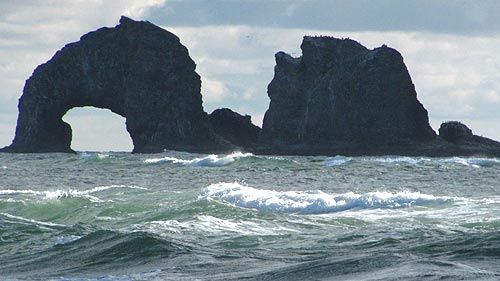
More About Oregon Coast hotels, lodging.....
More About Oregon Coast Restaurants, Dining.....
LATEST Related Oregon Coast Articles
Landmarks now gone and other exceptional moments
ODOT: Little Humbug Bridge On Route to N. Oregon Coast Soon Under Constructio...
Near MP 8 on Hwy 26 to Seaside / Cannon Beach
Octopus Tree Atop Cape Meares: History, Hikes, Rumors of the Oregon Coast Celeb
Near Oceanside: how old, is it the tallest, shape, freaky facts, rumors
Eclipse Weather for Oregon, Washington, Coastlines - How Clouds May Help Some...
Oregon and Washington will only get 23 percent or less of the sun. Weather, sciences
Oregon Coast / Washington Coast Answers: Those Strange, Snake-like Whips or T...
Bull kelp are a fun mystery on Northwest beaches. Marine sciences
Coffee 'n Treats for Trash: N. Oregon Coast Town Makes Picking Up Litter Yummy
Seaside gives you coffee and / or treats to fill bags with beach litter. Seaside events
5 Astounding Balcony Views on Oregon Coast
Exceptional views and finds around Cannon Beach, Lincoln City, Newport. Cannon Beach hotel reviews, Manzanita hotel reviews, Lincoln City hotels, Newport hotel reviews
Outstanding Hotels / Places to Stay at Gold Beach: Quirky Gems of S. Oregon C...
Gold Beach boasts a lot more than many may know. Gold Beach hotel reviews
Back to Oregon Coast
Contact Advertise on BeachConnection.net
All Content, unless otherwise attributed, copyright BeachConnection.net Unauthorized use or publication is not permitted














